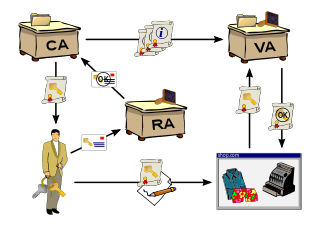
RIPEMD is a family of cryptographic hash functions developed in 1992 and 1996. There are five functions in the family: RIPEMD, RIPEMD-128, RIPEMD-160, RIPEMD-256, and RIPEMD-320, of which RIPEMD-160 is the most common.
In cryptography, Triple DES, officially the Triple Data Encryption Algorithm, is a symmetric-key block cipher, which applies the DES cipher algorithm three times to each data block. The Data Encryption Standard's (DES) 56-bit key is no longer considered adequate in the face of modern cryptanalytic techniques and supercomputing power. A CVE released in 2016, CVE-2016-2183 disclosed a major security vulnerability in DES and 3DES encryption algorithms. This CVE, combined with the inadequate key size of DES and 3DES, NIST has deprecated DES and 3DES for new applications in 2017, and for all application by 2023. It has been replaced with the more secure, more robust AES.
Transport Layer Security (TLS), the successor of the now-deprecated Secure Sockets Layer (SSL), is a cryptographic protocol designed to provide communications security over a computer network. The protocol is widely used in applications such as email, instant messaging, and voice over IP, but its use in securing HTTPS remains the most publicly visible.

A public key infrastructure (PKI) is a set of roles, policies, hardware, software and procedures needed to create, manage, distribute, use, store and revoke digital certificates and manage public-key encryption. The purpose of a PKI is to facilitate the secure electronic transfer of information for a range of network activities such as e-commerce, internet banking and confidential email. It is required for activities where simple passwords are an inadequate authentication method and more rigorous proof is required to confirm the identity of the parties involved in the communication and to validate the information being transferred.

Daniel Julius Bernstein is an American German mathematician, cryptologist, and computer scientist. He is visiting professor at CASA at Ruhr University Bochum, as well as a Research Professor of Computer Science at the University of Illinois at Chicago. Before this, he was a professor in the department of mathematics and computer science at the Eindhoven University of Technology

OpenSSL is a software library for applications that secure communications over computer networks against eavesdropping or need to identify the party at the other end. It is widely used by Internet servers, including the majority of HTTPS websites.
NTRU is an open source public-key cryptosystem that uses lattice-based cryptography to encrypt and decrypt data. It consists of two algorithms: NTRUEncrypt, which is used for encryption, and NTRUSign, which is used for digital signatures. Unlike other popular public-key cryptosystems, it is resistant to attacks using Shor's algorithm. NTRUEncrypt was patented, but it was placed in the public domain in 2017. NTRUSign is patented, but it can be used by software under the GPL.
In cryptography, Camellia is a symmetric key block cipher with a block size of 128 bits and key sizes of 128, 192 and 256 bits. It was jointly developed by Mitsubishi Electric and NTT of Japan. The cipher has been approved for use by the ISO/IEC, the European Union's NESSIE project and the Japanese CRYPTREC project. The cipher has security levels and processing abilities comparable to the Advanced Encryption Standard.
A security protocol is an abstract or concrete protocol that performs a security-related function and applies cryptographic methods, often as sequences of cryptographic primitives. A protocol describes how the algorithms should be used and includes details about data structures and representations, at which point it can be used to implement multiple, interoperable versions of a program.

GnuTLS is a free software implementation of the TLS, SSL and DTLS protocols. It offers an application programming interface (API) for applications to enable secure communication over the network transport layer, as well as interfaces to access X.509, PKCS #12, OpenPGP and other structures.

Network Security Services (NSS) is a collection of cryptographic computer libraries designed to support cross-platform development of security-enabled client and server applications with optional support for hardware TLS/SSL acceleration on the server side and hardware smart cards on the client side. NSS provides a complete open-source implementation of cryptographic libraries supporting Transport Layer Security (TLS) / Secure Sockets Layer (SSL) and S/MIME. NSS releases prior to version 3.14 are tri-licensed under the Mozilla Public License 1.1, the GNU General Public License, and the GNU Lesser General Public License. Since release 3.14, NSS releases are licensed under GPL-compatible Mozilla Public License 2.0.
CryptGenRandom is a deprecated cryptographically secure pseudorandom number generator function that is included in Microsoft CryptoAPI. In Win32 programs, Microsoft recommends its use anywhere random number generation is needed. A 2007 paper from Hebrew University suggested security problems in the Windows 2000 implementation of CryptGenRandom. Microsoft later acknowledged that the same problems exist in Windows XP, but not in Vista. Microsoft released a fix for the bug with Windows XP Service Pack 3 in mid-2008.
In cryptography, Curve25519 is an elliptic curve offering 128 bits of security and designed for use with the elliptic curve Diffie–Hellman (ECDH) key agreement scheme. It is one of the fastest ECC curves and is not covered by any known patents. The reference implementation is public domain software.
Mbed TLS is an implementation of the TLS and SSL protocols and the respective cryptographic algorithms and support code required. It is distributed under the Apache License version 2.0. Stated on the website is that Mbed TLS aims to be "easy to understand, use, integrate and expand".
OpenDNSSEC is a computer program that manages the security of domain names on the Internet. The project intends to drive adoption of Domain Name System Security Extensions (DNSSEC) to further enhance Internet security.
wolfSSL is a small, portable, embedded SSL/TLS library targeted for use by embedded systems developers. It is an open source implementation of TLS written in the C programming language. It includes SSL/TLS client libraries and an SSL/TLS server implementation as well as support for multiple APIs, including those defined by SSL and TLS. wolfSSL also includes an OpenSSL compatibility interface with the most commonly used OpenSSL functions.
Crypto++ is a free and open-source C++ class library of cryptographic algorithms and schemes written by Wei Dai. Crypto++ has been widely used in academia, student projects, open source and non-commercial projects, as well as businesses. Released in 1995, the library fully supports 32-bit and 64-bit architectures for many major operating systems and platforms, including Android, Apple, BSD, Cygwin, IBM AIX and S/390, Linux, MinGW, Solaris, Windows, Windows Phone and Windows RT. The project also supports compilation using C++03, C++11, C++14 and C++17 runtime libraries; and a variety of compilers and IDEs, including Borland Turbo C++, Borland C++ Builder, Clang, CodeWarrior Pro, GCC, Intel C++ Compiler (ICC), Microsoft Visual C/C++, and Sun Studio.
The Transport Layer Security (TLS) protocol provides the ability to secure communications across networks. This comparison of TLS implementations compares several of the most notable libraries. There are several TLS implementations which are free software and open source.

Matthew Daniel Green is a cryptographer and security technologist. Green is an Associate Professor of Computer Science at the Johns Hopkins Information Security Institute. He specializes in applied cryptography, privacy-enhanced information storage systems, anonymous cryptocurrencies, elliptic curve crypto-systems, and satellite television piracy. He is a member of the teams that developed the Zerocoin anonymous cryptocurrency and Zerocash. He has also been influential in the development of the Zcash system. He has been involved in the groups that exposed vulnerabilities in RSA BSAFE, Speedpass and E-ZPass.
The tables below compare cryptography libraries that deal with cryptography algorithms and have API function calls to each of the supported features.






